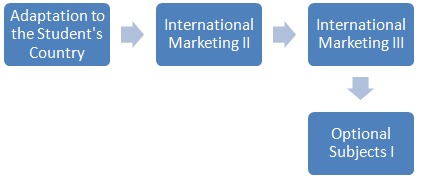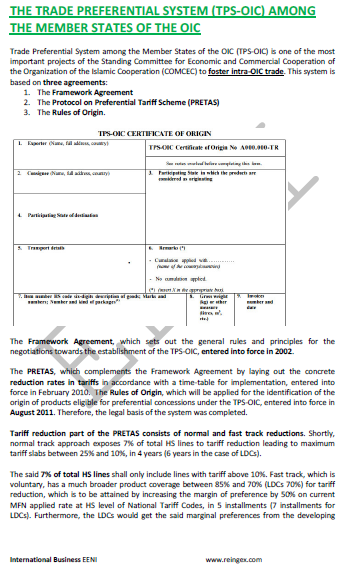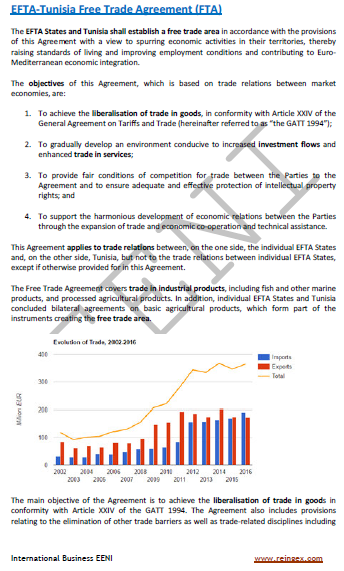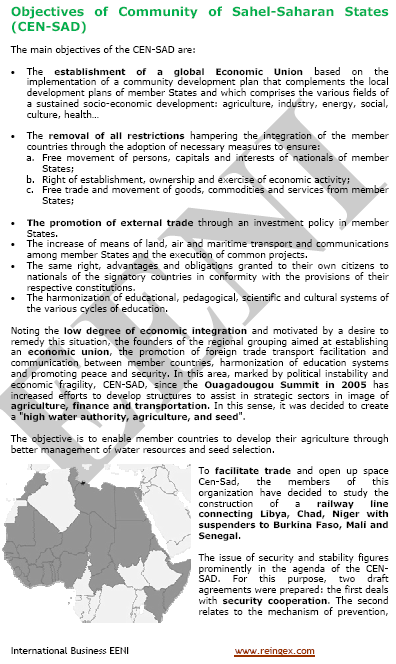Adaptation Maghrebian Students (e-Bachelor, Trade)
Adaptation of the Bachelor of Science in International Trade to Maghrebian Students (eLearning)
| Bachelor of Science in International Trade |

Subject - “Adaptation of the Bachelor of Science to Maghrebian Students (Study of the main regional economic institutions of the region where the student lives)” (5 ECTS) - Online Bachelor of Science in International Trade (fourth semester).
Subjects for the Maghrebian Students
Proposed subjects for the Maghrebian Students: Morocco, Algeria, Tunisia, Libya, and Mauritania.
- Arab Maghreb Union (AMU)
- Agadir Agreement (Arab Mediterranean Free Trade Agreement)
- CEN-SAD
- Relations with the EU
- EU-Morocco Economic Association Agreement
- EU-Algeria Association Agreement
- Euro-Mediterranean Partnership
- European Neighborhood Policy
- European Free Trade Association Agreements with Morocco and Tunisia
- Trade Agreements (ALE) of Morocco with the U.S. and Turkey
- Organization of Islamic Cooperation
- Trade Preferential System of the OIC
- Mauritania
- G5 Sahel
- Libya
- Common Market for Eastern and Southern Africa (COMESA)
- Tripartite Agreement COMESA-EAC-SADC
Syllabus of the Program: Arab Maghreb Union (AMU).
- Introduction to the Arab Maghreb Union (AMU): Algeria, Libya, Morocco, Mauritania, and Tunisia
- Treaty of Marrakech
- Objectives and mission of the Arab Maghreb Union
- Institutions of the Arab Maghreb Union (AMU)
- Maghrebian Bank for Investment and Trade (BMICE)
- Economy of the Maghreb
- Economic Integration in the region of the Arab Maghreb Union
- Competitiveness of the Maghrebian countries
- International Trade of the countries of the AMU
Objectives of the Program “Arab Maghreb Union (AMU)”:
- To understand the objectives and institutions of the Arab Maghreb Union
- To evaluate the advantages for the member countries and the areas of cooperation of the AMU
- To analyze the competitiveness of the Maghrebian countries
- To analyze the Economic Integration process (free movement of persons, services and merchandises, Common Market...) and the International Trade between the member countries of the Arab Maghreb Union
- To know the role of the Maghrebian Bank for Investment and Trade
Agadir Agreement (Arab Mediterranean Free Trade Agreement).
- Introduction to the Arab Mediterranean Free Trade Agreement (Agadir Agreement)
- Member countries of the Agadir Agreement: Egypt, Morocco, Tunisia, and Jordan
- Role of the EU in the Agadir Agreement
- Pan-Euro-Mediterranean System of accumulation of Origin
- International Trade between the member countries of the Agadir Agreement
- Automotive sector in the Agadir Agreement
Syllabus of the Program: Community of Sahel-Saharan States (CEN-SAD).
- Introduction to the Community of Sahel-Saharan States (CEN-SAD)
- Member states of the CEN-SAD
- Sahel-Saharan Bank for Investment and Trade (BSIC)
- Regional Food Security Programme
- African Initiative of the Great Green Wall
Objectives of the Program “Community of Sahel-Saharan States (CEN-SAD)”:
- To understand the objectives of the CEN-SAD
- To evaluate the advantages for the member countries of the Community of Sahel-Saharan States
- To analyze the areas of cooperation and programs of the CEN-SAD
- To know the role of the Sahel-Saharan Bank for Investment and Trade
Syllabus of the Program: Common Market for Eastern and Southern Africa (COMESA).
- Introduction to Common Market for Eastern and Southern Africa (COMESA)
- Decision Making of the COMESA
- COMESA Integration Process;
- Free-Trade Area of the Common Market for Eastern and Southern Africa
- COMESA Customs Union
- COMESA Common Market
- COMESA Economic Community
- Trade facilitation in the Common Market for Eastern and Southern Africa
- Simplified cross-border procedures for small companies
- Non-tariff Barriers to Trade elimination
- Economy of the COMESA region.
- International Trade of the COMESA
- Intra-COMESA Trade
- Trade in services
- Investments in the COMESA region
- Industry
- Energy
- Agriculture of the region of the Common Market for Eastern and Southern Africa
- Comprehensive Africa Agriculture Development Programme
- Alliance for Commodity Trade in Eastern and Southern Africa
- Harmonization Program of Sanitary and Phytosanitary Measures
- Infrastructures in the COMESA region.
- Transport facilitation
- Information and communication technologies
- Institutions and Agencies of the Common Market for Eastern and Southern Africa
- COMESA Reinsurance Company
- COMESA Regional Investment Agency
- African Trade Insurance Agency
- Federation of National Associations of Women in Business of the COMESA
- COMESA Entrepreneurs Council
Objectives of the Program “Common Market for Eastern and Southern Africa”:
- To understand the objectives, functions and institutions of the Common Market for Eastern and Southern Africa
- To know the economy of the COMESA region
- To analyze the COMESA Integration Process: the free-trade area, the Customs Union, the Common Market and the Economic Community COMESA
- To evaluate the advantages for the member countries of the COMESA
- To know the COMESA trade and transport facilitation programs
- To analyze the role of the affiliated institutions: the Bank of the ZEP, AIRC, the COMESA Reinsurance Company, ACA
United States-COMESA Trade and Investment Framework Agreement.
- The U.S.-COMESA countries (Common Market for Eastern and Southern Africa) Trade and Investment Framework Agreement (TIF)
- International Trade between the U.S. and the countries of the COMESA
- Advantages of the U.S.-COMESA Trade and Investment Framework Agreement
Syllabus of the Program: COMESA-EAC-SADC Tripartite Free Trade Agreement.
- Introduction to the COMESA-EAC-SADC Tripartite FTA
- Institutional framework
- Areas of intervention
- Tripartite free-trade area
- Trade facilitation and Transport
- Infrastructure Development
- Mechanisms related to trade
- Corridors and infrastructures of the COMESA-SADC-EAC region
- towards the African Continental Free-Trade Area
Objectives of the Program “COMESA-EAC-SADC Tripartite Free Trade Agreement”:
- To understand the objectives (Customs Union) and the areas of cooperation of the COMESA-EAC-SADC Tripartite FTA
- To evaluate the advantages for the member countries of the tripartite
- To understand the advantages of the Tripartite free-trade area
- To analyze trade facilitation programs, transportation, and non-tariff barriers elimination
- To understand the Tripartite Agreement as a stage towards the African Continental Free-Trade Area
Syllabus of the Program: Euro-Mediterranean Partnership (EUROMED) of the EU
- Introduction to Euro-Mediterranean Partnership (EUROMED) of the EU
- Union for the Mediterranean
- Barcelona Declaration
- Pan-Euro-Mediterranean System of accumulation of Origin
- Euro-Mediterranean trade relations
- Arab Mediterranean FTA
- International Trade of the EU with the countries of the South of the Mediterranean
Objectives of the Program “Euro-Mediterranean Partnership (EUROMED) of the EU”:
- To know the fundamentals of the Euro-Mediterranean Partnership
- To investigate trade relations and the EU Association Agreements with the countries of the South of the Mediterranean
Syllabus of the Program: European Neighborhood Policy of the EU.
- Introduction to the European Neighborhood Policy of the EU
- European Neighborhood Policy with Morocco and Tunisia
Objectives of the Program “European Neighborhood Policy”:
- To know the strategic importance of the European Neighborhood Policy
- To investigate trade relations between the EU and Morocco and Tunisia
European Union-Morocco Association Agreement.
- Introduction to the EU-Morocco Association Agreement
- Characteristics of the Morocco-EU Association Agreement
European Union-Algeria Association Agreement.
- Introduction to the EU-Algeria Association Agreement
- Safeguard Measures
- Pan-Euro-Mediterranean System of accumulation of Origin
- International Trade Algeria-EU
Syllabus of the Program: Africa-European Union Strategic Partnership (EU)
- Introduction to the Africa-European Union Strategic Partnership (EU). The Cotonou Agreement
- Fiduciary Fund European Union-Africa for the infrastructures
- Cotonou Agreement
- ACP countries
- Barcelona Declaration and the Euro-Mediterranean Partnership
- European Neighborhood Policy
- Bilateral relations Africa-EU
Syllabus of the Program: Generalized System of Preferences (GSP) of the EU.
- Introduction to Generalized System of Preferences (GSP) of the EU
- New GSP System
- Beneficiary countries under the current GSP
- Revised EU trade scheme to help the developing countries
- Practical guide to the new GSP trade regimes for the Developing Countries
- Products enjoying preferences in the reformed Generalized System of Preferences
- European Union's Foreign Trade with GSP countries
- GSP+ scheme
- Everything But Arms arrangement (EBA)
- Duty-free and Quota-free treatment for all least-developed countries
- GSP rules of origin
- Tolerance or De Minimis
- Types of accumulation
Objectives of the Program “Generalized System of Preferences (GSP)”:
- To know the characteristics of the new Generalized System of Preferences (GSP) of the EU
- To know which countries and under what conditions are beneficiaries of the GSP
- To analyze the SPG + scheme and the arrangement Everything but Arms
- To know how to use the rules of origin under the Generalized System of Preferences
Syllabus of the Program: African Growth and Opportunity Act (AGOA).
- Introduction to the AGOA
- AGOA V
- Eligibility criteria: countries and products. The case of the African textiles
- International Trade between the U.S. and Africa
- The main export markets
- The largest suppliers of Sub-Saharan Africa to the U.S.
- North American Investment in Africa
- African Foreign Trade Centre
- Case Study:
- Handcrafts export growth in Ghana
- Senegalese Exporters
- African Growers at Floral Show in Atlanta
Objectives of the Program “African Growth and Opportunity Act (AGOA)”:
- To understand the objectives of the African Growth and Opportunity Act
- To evaluate the admission criteria by country and product eligibility
- To understand the general rules of origin for textiles under the AGOA
- To analyze the access to the U.S. Market for the African products under the AGOA
- To know the trade agreements between the African Countries and the U.S.
- To analyze the international trade between the African Countries and the U.S.
Syllabus of the Program: Organization of Islamic Cooperation (OIC).
- Introduction to the Organization of Islamic Cooperation (OIC)
- The Ummah
- Subsidiary Organs of the OIC
- Committee for Economic Cooperation (OIC)
- Economic Centre for Islamic Countries
- Islamic Centre for Development of Trade
- Islamic Fiqh Academy
- Islamic Solidarity Fund and the Waqf
- Trade Preferential System between the member states of the OIC
- Institutions and specialized agencies of the Islamic Cooperation
- Islamic Development Bank (IADB)
- Islamic Chamber of Commerce and Industry
- Economic Report on the countries of the OIC
- Cairo Declaration on Human Rights in Islam
- Chart of the OIC
Standing Committee for Economic and Commercial Cooperation of the OIC (COMCEC).
- Introduction to the Standing Committee for Economic and Commercial Cooperation of the OIC
- Objectives of the Standing Committee for Economic and Commercial Cooperation
- Areas of cooperation of the Standing Committee for Economic and Commercial Cooperation of the OIC
- International Trade
- Transport
- Agriculture
- Tourism
- Financial cooperation
- Poverty reduction
- Private sector cooperation
- International Trade between the members of the OIC and the World
Statistical, Economic and Social Research and Training Centre for Islamic Countries (SESRIC).
- Introduction to Statistical, Economic and Social Research and Training Centre for Islamic Countries
- Department of economic and social research
- Economic Report on the member countries of the OIC
- Production, growth and employment
- Iintra-OIC Trade in merchandises
- FDI
- Financial sector
- Socio-economic statistics of slamic countries
Centre Islamic for the development of International Trade (CIDC).
- Introduction to Centre Islamic for Foreign Trade development
- Objectives of the Centre Islamic for Foreign Trade development
- International Trade and investment promotion
- Trends in international trade of the member states of the OIC
Trade Preferential System (SPC) of the OIC
- Introduction to the Trade Preferential System of the OIC
- Framework Agreement on the Trade Preferential System of the OIC
- Protocol on the Preferential Tariff Scheme (PRETAS)
- Rules of origin
Islamic Chamber of Commerce and Industry.
- Introduction to the Islamic Chamber of Commerce and Industry (CICI)
- Objectives of the Islamic Chamber of Commerce and Industry
- Islamic Finance: Opportunities, Challenges, and Policy Options
- Sukuk Markets
- Waqf Funds
- An Assessment of foreign trade cost in the countries of the OIC
Objectives of the Program “Organization of Islamic Cooperation”:
- To understand the objectives and the areas of cooperation of the OIC
- To understand the relationships of the OIC with the Ummah
- To know the affiliated institutions of the OIC: the Standing Committee for Economic and Commercial Cooperation, the SESRIC.
- To understand the role of the Islamic Centre for Development of Trade (intra-Arab Trade promotion) and the Islamic Chamber of Commerce and Industry
- To analyze the Trade Preferential System between the member states of the OIC (PRETAS, rules of origin...)
Subjects of the fourth semester of the Bachelor of Science in International Trade.

ECTS: European Transfer and Accumulation System
Samples: adaptation of the Bachelor of Science to Maghrebian Students (Study of the main regional economic institutions of the region where the student lives) (Bachelor of Science in International Trade, e-learning, fourth semester).





Language of the subject “adaptation of the Bachelor of Science to Maghrebian Students (Study of the main regional economic institutions of the region where the student lives)” of the Bachelor of Science in International Trade (fourth semester):  or or
or or  EENI
EENI  EENI
EENI  EENI.
EENI.
(c) EENI Global Business School (1995-2024)
We do not use cookies
Top of this page

